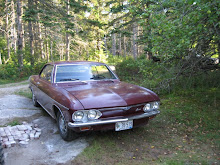Over the two decades of owning the QE I, I've accumulated over 400,000 miles with the car; it came with 111,000. As with any classic car, the Land Rover has its strengths and weaknesses.
One strength is that, for the most part, you can repair it in the field, in situ. While it's nice a garage or high end tools are not required for most repairs. This is a good thing as one weakness of the Series Land Rover rests with its shift lever. On the Series II/II-A [1958 - 1972] the shift lever resembles a paper clip after you've finished untwisting it. The lever has one "S" curve near the base and then it travels up a considerable distance so you can shift it without leaning forward. The Series III [1972- 1985] lever travels straight up, something Land Rover believed would create a "modern" look to the "upgraded" interior.
Both levers, however, have a weak spot right at the base, where the lever disappears into the transmission tunnel cover. It seems that the lever is welded in place onto a ball, and that's exactly where they break at the exact wrong time.
The first time it happened to me I had just brought my Land Rover back to my former place of employment, a television network office in New Hampshire. I had been let go from there in a round of budget cuts about 6 months earlier but when free lance work took me nearby, I stopped to say "hello" to former peers. I also wanted to show off my then-new purchase, the QE I. As I pulled nose first into a parking spot in front of the building, the shift lever came off in my hand. I had no idea what to do, so I called the Previous Owner. "It's an easy fix," he said," just start unscrewing everything on the floor. I'll be over in about an hour with a replacement one for you." So I started unscrewing everything I could see and had it mostly in pieces when he arrived in the pitch black with the replacement lever. Sure enough, it really did just bolt onto the top of the transmission linkage. The floors really did come up in pieces, as did the transmission cover. I was on my way within another hour.
The replacement one was a Series III straight lever, which I didn't mind, sort of, but when, a few years later in MA, a friend offered my a proper II-A bent lever, I accepted and went through the entire drill again.
My third time came with the QM I, when a buddy used it for a couple of months one summer on the island. I saw him walking up our main street one day with the shift lever in his hand. He looked quite distraught and upset. I assured him the job would not be too difficult and that I had a spare one on hand. "But it broke down at the boatyard," he said. That galvanized me into action; the boatyard owner always looked for opportunities to rag me about my Land Rovers. If he saw one broken down at his yard, it would be in the sea in no time! I repaired it quickly that very night.
The fourth time happened while on the trails, in low range, during the 2010 Maine Winter Romp. My companion was a friend's son, a Coast Guardie on his first off road event. As I shifted into 3rd gear low range, I noticed the lever move way over towards the right, too far. "Something's not right," I said, at which point the lever came off in my hand. By then I was also in neutral, in the middle of a convoy, miles from any real road. With the help of friends, we exposed the hole on the side of transmission tunnel that lets you get a screwdriver into the linkage. That moved the car into 3rd gear, and using the overdrive as a 3/4 shift, I exited the trail and headed towards the rally garage in Unity. There Bruce Fowler, the event organizer, loaned me his RHD Series II-A shift lever. I installed it with more help from other rallyists, and headed home the next day with a "new" shifter.
The strange part of using it came from the different angle required because of its RHD construction. The shift pattern is the same on Land Rovers, whether LHD or RHD, but because of the orientation of the steering wheel, the RHD lever bends at a slightly different angle. For about a month, every shift seemed strange and out of sorts until I got used to the new angles.
I got our local welder to take a stab at fixing the old one and spent this morning installing it again - now replacement #5. I will return the RHD one to its owner this weekend at the 2011 Maine Winter Romp, and hope I don't have to revisit unscrewing/unbolting floor panels, transmission covers and overdrive levers for another few years.
Wednesday, February 16, 2011
Subscribe to:
Comments (Atom)







